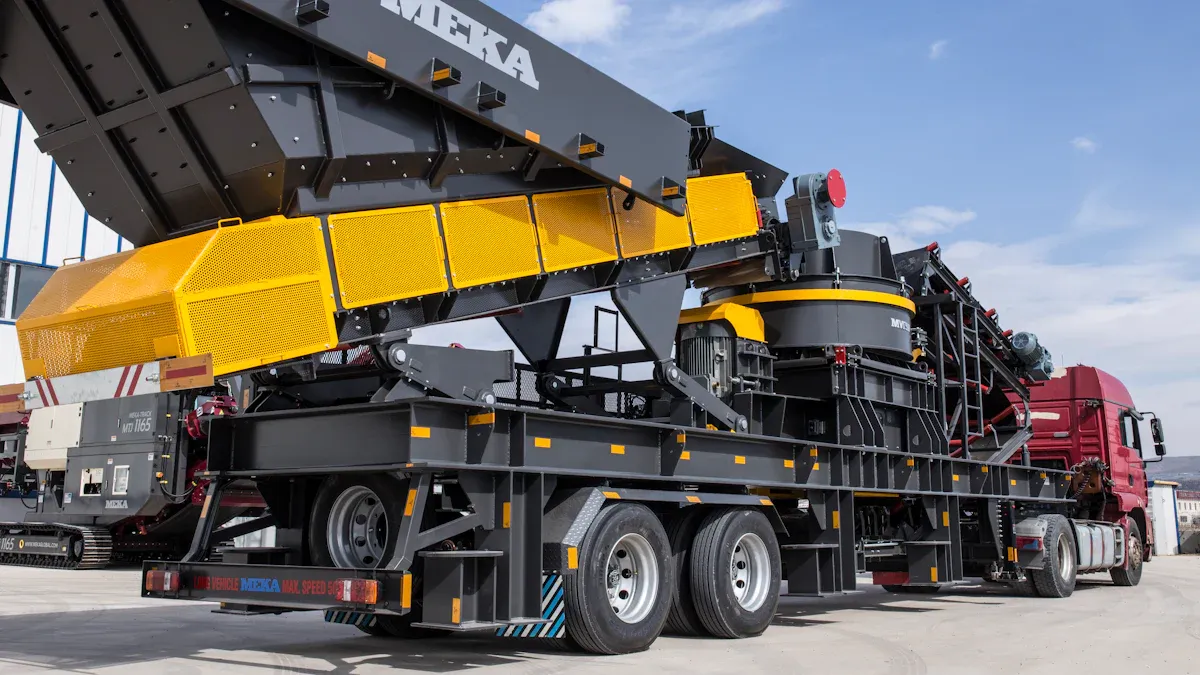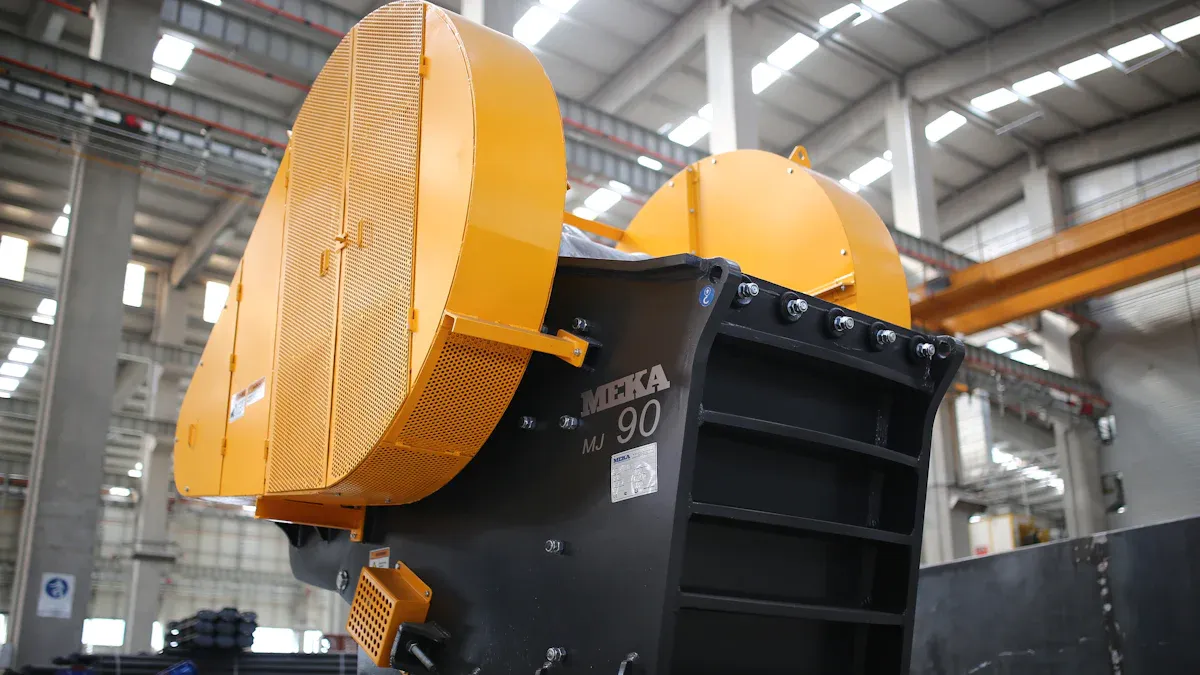
A čeľusťový drvičmôžezvýšiť produktivitupre banské alebo stavebné projekty. Možnosti dizajnu, ako napríkladmangánová čeľusťová doskaa silnýdiely drvičaudržaťzávod na čeľusťové drvičedlhšie beží. Inteligentné funkcie, ako napríkladmonitorovanie v reálnom čase, pomáhajú firmám ušetriť na údržbe a vyhnúť sa prestojom.
Kľúčové poznatky
- Výber toho správnehočeľusťový drvičZvyšuje produktivitu a šetrí peniaze prispôsobením stroja typu materiálu, veľkosti projektu a požadovanému výstupu.
- Silný dizajn, jednoduchá údržba a spoľahlivá podpora značky znižujú prestoje a náklady na opravy, čím udržiavajú váš projekt v chode a ziskový.
- Zvážte dlhodobú hodnotu nad počiatočnou cenou vyvážením kapacity stroja, spotreby energie a popredajného servisu, aby ste zabezpečili hladkú prevádzku a rast podnikania.
Prečo je dôležité porovnávať značky čeľusťových drvičov
Vplyv na produktivitu a efektívnosť
Výber toho správnehočeľusťový drvičmôže mať veľký vplyv na to, koľko materiálu dokáže podnik spracovať každý deň. Napríklad prípadová štúdia ukázala, že keď malý mobilný čeľusťový drvič zvýšil svoju rýchlosť otáčania z 220 ot./min. na 300 ot./min., jeho priepustnosť prudko vzrástla.od 0,4 tony za hodinu do 0,7 tony za hodinuZmeny dizajnu, ako napríkladpridanie výstuh k doskám výkyvných čeľustíalebo použitie nastaviteľných prepínacích dosiek tiež pomáhajú zvýšiť efektivitu.Rôzne tvary čeľusťových dosiekmôže zmeniť jemnosť drveného materiálu. Tieto podrobnosti ukazujú, že aj malé rozdiely medzi strojmi môžu viesť k veľkým zmenám v produktivite.
Vplyv na celkové náklady na vlastníctvo
Keď spoločnosti porovnávajú značky čeľusťových drvičov, berú do úvahy viac než len cenu. Zohľadňujú spotrebu energie, potreby údržby a životnosť súčiastok.stôlnižšie sú uvedené niektoré kľúčové faktory:
| Faktor | Charakteristiky čeľusťového drviča | Charakteristiky kužeľového drviča | Dôsledky výberu pre podniky |
|---|---|---|---|
| Vhodnosť materiálu | Ideálne pre tvrdé, abrazívne materiály | Vhodnejšie pre stredne tvrdé až tvrdé materiály | Prispôsobte typ drviča tvrdosti a abrazivite materiálu |
| Veľkosť krmiva | Zvláda väčšie veľkosti podávania (až do 1 500 mm) | Vyžaduje menšiu, konzistentnú veľkosť podávaného materiálu (do 350 mm) | Vyberte na základe veľkosti vstupného materiálu |
| Výstup produktu | Produkuje širšiu škálu veľkostí a tvarov častíc | Vytvára rovnomernejší, kubický produkt | Vyberte podľa požadovaného tvaru a veľkosti produktu |
| Výrobná kapacita | Vo všeobecnosti vyššia (200 – 1 000 ton/hodinu) | Typicky nižšie (100 – 750 ton/hodinu) | Prispôsobte kapacitu drviča potrebám priepustnosti |
| Spotreba energie | Nižšia (1 – 2 kWh/tona) | Vyššia (2 – 4 kWh/tona) | Zvážte energetickú účinnosť, aby ste znížili prevádzkové náklady |
| Údržba a opotrebovanie | Jednoduchší dizajn, menej opotrebovateľných dielov | Zložitejšia konštrukcia, viac opotrebovateľných dielov | Vyhodnoťte zložitosť a náklady na údržbu |
| Počiatočné a prevádzkové náklady | Nižšia počiatočná investícia | Vyššia počiatočná investícia | Vyvážte počiatočné náklady s dlhodobými výdavkami |
| Vplyv na životné prostredie | Viac hluku a prachu pri primárnom drvení | Pri sekundárnom/terciárnom drvení vytvára jemnejší prach | Zvážte environmentálne predpisy a podmienky na mieste |
Pri pohľade na tieto faktory si firmy môžu vybrať čeľusťový drvič, ktorý vyhovuje ich potrebám a v priebehu času im ušetrí peniaze.
Vplyv na výsledky projektu a rast podnikania
Správny čeľusťový drvič pomáha dokončiť projekty včas a v rámci rozpočtu. Keď spoločnosť prispôsobí stroj úlohe – napríklad výberom takého, ktorý spracováva veľké veľkosti vstupných materiálov alebo tvrdé materiály – vyhne sa oneskoreniam a dodatočným nákladom. Dobrý výber vedie k lepšej kvalite produktov a vyšším ziskom. Spoločnosti, ktoréporovnajte značky a modelyčasto dosahujú lepšie výsledky a stabilný rast podnikania. Získajú tiež stroje, ktoré vydržia dlhšie a potrebujú menej opráv, čo umožňuje projektom napredovať.
Modely čeľusťových drvičov: Porovnanie vedľa seba

Kvalita dizajnu a spracovania popredných značiek
Keď sa niekto pozerá inakmodely čeľusťových drvičov, prvá vec, ktorú si všimnú, je dizajn a kvalita spracovania. Niektoré značky sa zameriavajú na pevné oceľové rámy a odliatky s odľahčeným pnutím. Iné používajú modulárne konštrukcie, ktoré uľahčujú opravy. NapríkladČeľusťový drvič EB používa vysoko kvalitnú oceľ a veľké zotrvačníkyaby stroj zostal stabilný. Model EB Pro má patentovanú výkyvnú čeľusť a kompaktný rám, vďaka čomu vydrží dlhšie a zvláda ťažké bremená. Čeľusťový drvič Jaw Gyratory Crusher Pro vyniká hydraulickým nastavením medzery a ochranou proti preťaženiu, vďaka čomu je dobrou voľbou pre náročné úlohy.
Tu je rýchly pohľad na porovnanie týchto modelov:
| Model | Rozsah kapacity (tph) | Veľkosť posuvu (mm) | Veľkosť produktu (mm) | Hlavné prvky dizajnu | Funkcie kvality zostavenia | Poznámky k výkonu |
|---|---|---|---|---|---|---|
| Čeľusťový drvič EB | Až 700 | 0 – 1200 | 0 – 200 / 0 – 300 | Optimálna rýchlosť, veľké zotrvačníky pre priepustnosť | Rám z vysoko kvalitnej ocele, odliatok uvoľnený od pnutia | Nižšie výkonové špičky, o >10 % dlhšia životnosť súčiastok, rovnomerné opotrebovanie |
| Čeľusťový drvič EB Pro | 300 – 1600 | Neuvedené | Neuvedené | Dizajn založený na bionike, modulárny a nenáročný na údržbu | Kompaktný a robustný, patentovaný dizajn výkyvnej čeľuste | Vyššia odolnosť, skrátené prevádzkové doby, absorbuje špičkové zaťaženie |
| Čeľusťový gyrátorický drvič Pro | Väčší ako séria EB | Zväčšený otvor na podávanie | Jemný a jednotný produkt | Hydraulické nastavenie medzery, ochrana proti preťaženiu | Priamy pohon s plávajúcim hriadeľom, cyklopaloidná prevodovka | Zvláda väčšie množstvo krmiva, vyšší drviaci pomer a väčšiu priepustnosť ako séria EB |
Metriky výkonu: Priepustnosť, Veľkosť vstupu/výstupu, Nastaviteľnosť
Výkon je dôležitýPri výbere čeľusťového drviča je to veľmi dôležité. Ľudia chcú vedieť, koľko materiálu stroj zvládne, akú veľkosť hornín dokáže zomlieť a aký jemný bude výstup. Niektoré stroje, ako napríklad čeľusťový drvič EB, dokážu spracovať až 700 ton za hodinu a zvládnu horniny s veľkosťou až 1200 mm. EB Pro zvládne ešte viac. Čeľusťový drvič Pro zvládne ešte väčšie horniny a poskytne jemnejší a rovnomernejší produkt.
Technické testy ukazujú, že malé zmeny v konštrukcii stroja môžu zmeniť výsledky. NapríkladDrvič s dlhšou komorou a menším excentrickým hodom produkuje jemnejší materiálale môže spotrebovať viac energie. Iný model so širším nastavením a kratšou komorou vyrába hrubší materiál, ale spotrebuje menej energie. Tieto rozdiely pomáhajú spoločnostiam vybrať si ten správny čeľusťový drvič pre ich potreby.
Vhodnosť aplikácie: Typy materiálov a rozsah projektu
Nie každý čeľusťový drvič je vhodný na každú prácu. Niektoré fungujú najlepšie na tvrdé horniny, ako je železná ruda alebo meď. Iné si poradia s mäkšími materiálmi alebo stavebným odpadom. Štúdie trhu ukazujú, žestroje s výkonom menej ako 300 ton za hodinu sú skvelé pre malé projektyModely s výkonom 300 až 800 ton za hodinu sú vhodné pre stredne veľké úlohy. Najväčšie stroje, ktoré dokážu spracovať viac ako 800 ton za hodinu, sú vhodné pre veľké banské prevádzky.
Tip: Spoločnosti v ázijsko-tichomorskom regióne si často vyberajú veľké čeľusťové drviče na ťažbu, zatiaľ čo Severná Amerika uprednostňuje prenosné modely na uhlie a meď. Európa sa zameriava na energetickú účinnosť a recykláciu.
Výber závisí od typu materiálu, veľkosti projektu a dokonca aj od regiónu, kde sa bude stroj používať.
Jednoduchá údržba a prestoje
Údržba môže byť kľúčová pre úspech projektu. Niektoré čeľusťové drviče majú modulárne diely a ľahko prístupné panely. Tieto funkcie pomáhajú pracovníkom rýchlejšie riešiť problémy a skrátiť prestoje. Správy ukazujú, že stroje s pevnými rámami a menším počtom pohyblivých častí sa porouchávajú menej často. Keď sa problémy vyskytnú,analýza základných príčin a lepšie plány údržby môžu skrátiť časy oprávNapríklad pridanie štrukturálnych výstuh alebo použitie lepších materiálov môže pomôcť predĺžiť životnosť stroja a zabezpečiť jeho plynulejší chod.
Dobre navrhnutý čeľusťový drvič udržiava nízke prestoje a vysokú produktivitu. Spoločnosti, ktoré sledujú časy opráv a plánujú pravidelné kontroly, zaznamenávajú menej porúch a z dlhodobého hľadiska šetria peniaze.
Popredajná podpora a záruka
Popredajná podpora je rovnako dôležitá ako samotný stroj. Popredné značky ponúkajú silné záruky a rýchly prístup k náhradným dielom. Niektoré spoločnosti poskytujú školenia pre pracovníkov a zákaznícky servis 24 hodín denne, 7 dní v týždni. Iné majú miestne servisné strediská, ktoré dokážu rýchlo poslať pomoc. Dobrá záruka sa vzťahuje na hlavné diely a poskytuje pokoj v duši. Rýchla podpora znamená menej čakania a viac práce.
Poznámka: Pred kúpou čeľusťového drviča si vždy overte, akú podporu a záruku značka ponúka. Dobrá podpora môže ušetriť čas a peniaze, ak sa niečo pokazí.
Porovnávacia tabuľka čeľusťových drvičov

Keď chce niekto porovnať rôzne čeľusťové drviče, tabuľka môže veci objasniť. Tabuľka nižšie zobrazuje dôležité vlastnosti a čísla, ktoré pomôžu kupujúcim pochopiť, čo každý model dokáže. Tieto podrobnosti pochádzajú zo skutočných zdrojov v odvetví a ukazujú, ako každý stroj funguje v praxi.
| Parameter | Detaily/Hodnoty |
|---|---|
| Maximálny redukčný pomer | 8:1 (kompresné drvenie) |
| Typické použitie | Primárny drvič |
| Pomenovanie čeľusťového drviča | Čísla ako 3042 znamenajú 30″ na šírku a 42″ na výšku. |
| Prípustná horná veľkosť | Približne 80 % šírky (napr. 24″ pre šírku 30″) |
| Nastavenie uzavretej strany (CSS) | Nastaviteľná; minimálne ~3″ pre veľkosť vrchu 24″ |
| Efektívnosť | 80 – 85 % (výstup pod veľkosťou CSS) |
| Výstupná gradácia | 80 – 85 % pod CSS; zvyšok medzi 7,5 – 15,5 cm |
| Určujúci faktor kapacity | Šírka čeľuste |
Tip: Šírka čeľuste často určuje, koľko materiálu stroj zvládne. Širšia čeľusť znamená väčšiu kapacitu.
Niektoré čeľusťové drviče používajújednoduché alebo dvojité prepínačeIné majú rôzne prevedenia, ako napríklad typy Blake alebo Dodge. Každý dizajn mení spôsob pohybu stroja a spotrebu energie. Ľudia si tiež môžu upraviť nastavenie zatvorenej strany, aby kontrolovali veľkosť hotového výrobku. Tieto čísla pomáhajú kupujúcim vybrať si ten správny.čeľusťový drvičpre ich potreby.
Ako si vybrať správny čeľusťový drvič pre vaše podnikanie
Posúdenie veľkosti projektu a materiálových požiadaviek
Každý projekt má jedinečné potreby. Spoločnosti by mali začať tým, že zvážia veľkosť svojho projektu a typ materiálu, ktorý potrebujú drviť. Napríklad niektoré materiály akoPMMA potrebuje na drvenie viac energienež iné, ako napríklad PP. Nasledujúca tabuľka ukazuje, ako rôzne materiály ovplyvňujú spotrebu energie a výkon:
| Typ materiálu | Merná energia (kWh) | Výkon (Mg/h) | Energia drvenia (%) |
|---|---|---|---|
| PMMA | 1,63 | 0,05 | 66,04 |
| PP | 0,79 | 0,1 | 47,78 |
Spoločnosti tiež používajú krivky veľkosti zŕn a nastavenia drviča, aby prispôsobili čeľusťový drvič svojim potrebám. Zohľadňujú veľkosť vstupného materiálu, otvor drviča a veľkosť konečného produktu. To im pomáha vybrať stroj, ktorý vyhovuje ich projektu a materiálu.
Vyrovnávanie rozpočtu a dlhodobej hodnoty
Výber čeľusťového drviča nie je len o cene.Menšie stroje stoja meneja ľahšie sa premiestňujú a udržiavajú. Sú vhodné pre menšie úlohy. Väčšie stroje sú drahšie, ale zvládnu väčšie projekty a pri častom používaní sa rýchlejšie vyplatia. Spoločnosti by mali prispôsobiť veľkosť stroja svojmu pracovnému zaťaženiu. Ak si vyberú príliš malý stroj, môžu sa stretnúť s oneskoreniami. Ak si vyberú príliš veľký stroj, môžu premárniť peniaze. Dôležité je aj plánovanie budúceho rastu.
- Menšie drviče: nižšie náklady, jednoduchá údržba, najlepšie pre malé úlohy.
- Väčšie drviče: vyššie náklady, rýchlejšia práca, lepšie pre veľké projekty.
Hodnotenie reputácie značky a podporných služieb
Dobrá značka môže mať veľký vplyv. Spoločnosti by si mali overiť, či značka ponúka silnú podporu a dobrú záruku. Rýchla pomoc a jednoduchý prístup knáhradné dielyUdržujte čeľusťový drvič v chode. Školenia a miestne servisné strediská pridávajú dodatočnú hodnotu. Dôveryhodná značka poskytuje pokoj v duši a pomáha projektom prebiehať hladko.
Tip: Pred kúpou sa vždy informujte o popredajnej podpore. Dobrý servis môže ušetriť čas a peniaze.
Nedávne pokroky, ako napríkladhybridné a elektrické modelyukážte, ako si vybrať ten správnyČeľusťový drvičmôže znížiť náklady, zvýšiť produkciu a podporiť ekologické ciele. S rastom trhu inteligentní kupujúci prispôsobujú stroje svojim potrebám. Často sa rozprávajú s odborníkmi, aby si pre svoje podnikanie vybrali čo najlepšie.
Často kladené otázky
Aká je hlavná úloha čeľusťového drviča?
A čeľusťový drvičRozbíja veľké skaly na menšie kusy. Používa silné čeľuste na drvenie tvrdých materiálov pre stavebné alebo banské projekty.
Ako často by mal niekto vykonávať servis čeľusťového drviča?
Väčšina značiek odporúča skontrolovať aservis strojakaždých 250 hodín. Pravidelná starostlivosť pomáha predĺžiť životnosť stroja a zlepšiť jeho výkon.
Dokáže jeden čeľusťový drvič pracovať so všetkými druhmi materiálov?
Nie, niektoré stroje si lepšie poradia s tvrdými kameňmi. Iné fungujú najlepšie s mäkšími materiálmi. Pred začatím nového projektu si vždy skontrolujte špecifikácie stroja.
Čas uverejnenia: 26. júna 2025